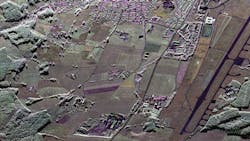BAE Systems, Utah State, to develop algorithms that recognize moving targets in synthetic aperture radar
WRIGHT-PATTERSON AFB, Ohio – U.S. military researchers are asking two more signal-processing companies to develop algorithms and collection techniques to enable synthetic aperture radar (SAR) sensors to detect, geolocate, and image moving targets on the ground.
Officials of the U.S. Air Force Research Laboratory at Wright-Patterson Air Force Base, Ohio, on Tuesday announced a $5.2 million contract to the BAE Systems Electronic Systems segment in San Diego and a $4.1 million contract to the Utah State University Space Dynamics Laboratory in Logan, Utah, for the Moving Target Recognition (MTR) project.
MTR revolves around developing algorithms that recognize slow-moving military vehicle targets with synthetic aperture radar (SAR) signatures that are superimposed on clutter. The Air Force awarded the contract on behalf of the U.S. Defense Advanced Research Projects Agency (DARPA) in Arlington, Va.
BAE Systems and Utah State join the KBR Inc. Centauri segment in Chantilly, Va., on the MTR program. KBR won an $11.1 million MTR contract in April.
MTR will include airborne data collection experiments to test and evaluate algorithms to detect moving ground targets. The MTR contractors will be responsible for the airborne radar sensors and flight services, while DARPA will handle designing experiments that involve moving ground vehicles, instrumented to provide ground truth.
If the project succeeds at moving target detection, geolocation, and imaging, MTR will start developing ATR algorithms for moving target images.
Related: SAR imaging technology to match infrared pursued by Raytheon, Nuvotronics, BAE Systems
The MTR program is part of the DARPA Mosaic Warfare vision, which seeks to create rapidly reconfigurable military forces that are fast, unpredictable, flexible, and adaptable -- more like the pieces in a mosaic piece of art, rather than a collection of rigidly designed pieces of a puzzle.
The MTR program has two phases: a two-year effort that focuses on locating moving targets, as well as detection and imaging; and automatic target recognition (ATR) of the moving target images.
For more information contact BAE Systems Electronic Systems online at www.baesystems.com, the Utah State Space Dynamics Laboratory at www.sdl.usu.edu, KBR Centauri online at www.kbr.com/en/centauri, the Air Force Research Laboratory at www.afrl.af.mil,, or DARPA at www.darpa.mil.
About the Author
John Keller
Editor-in-Chief
John Keller is the Editor-in-Chief, Military & Aerospace Electronics Magazine--provides extensive coverage and analysis of enabling electronics and optoelectronic technologies in military, space and commercial aviation applications. John has been a member of the Military & Aerospace Electronics staff since 1989 and chief editor since 1995.
